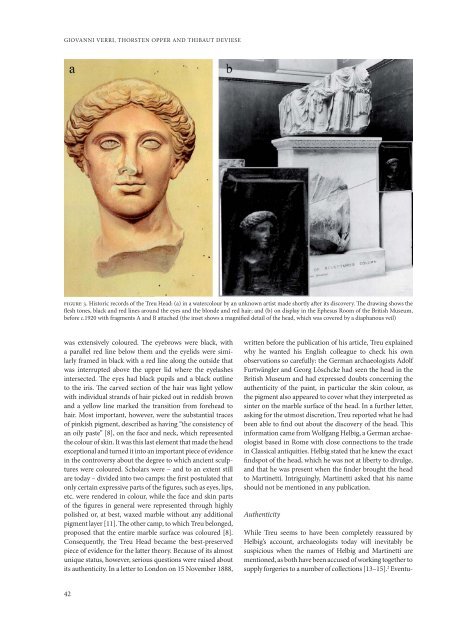You also want an ePaper? Increase the reach of your titles
YUMPU automatically turns print PDFs into web optimized ePapers that Google loves.
GIOVANNI VERRI, THORSTEN OPPER AND THIBAUT DEVIESE<br />
figure 3. Historic records of the Treu Head: (a) in a watercolour by an unknown artist made shortly after its discovery. <strong>The</strong> drawing shows the<br />
flesh tones, black and red lines around the eyes and the blonde and red hair; and (b) on display in the Ephesus Room of the <strong>British</strong> <strong>Museum</strong>,<br />
before c.1920 with fragments A and B attached (the inset shows a magnified detail of the head, which was covered by a diaphanous veil)<br />
was extensively coloured. <strong>The</strong> eyebrows were black, with<br />
a parallel red line below them and the eyelids were similarly<br />
framed in black with a red line along the outside that<br />
was interrupted above the upper lid where the eyelashes<br />
intersected. <strong>The</strong> eyes had black pupils and a black outline<br />
to the iris. <strong>The</strong> carved section of the hair was light yellow<br />
with individual strands of hair picked out in reddish brown<br />
and a yellow line marked the transition from forehead to<br />
hair. Most important, however, were the substantial traces<br />
of pinkish pigment, described as having “the consistency of<br />
an oily paste” [8], on the face and neck, which represented<br />
the colour of skin. It was this last element that made the head<br />
exceptional and turned it into an important piece of evidence<br />
in the controversy about the degree to which ancient sculptures<br />
were coloured. Scholars were – and to an extent still<br />
are today – divided into two camps: the first postulated that<br />
only certain expressive parts of the figures, such as eyes, lips,<br />
etc. were rendered in colour, while the face and skin parts<br />
of the figures in general were represented through highly<br />
polished or, at best, waxed marble without any additional<br />
pigment layer [11]. <strong>The</strong> other camp, to which Treu belonged,<br />
proposed that the entire marble surface was coloured [8].<br />
Consequently, the Treu Head became the best-preserved<br />
piece of evidence for the latter theory. Because of its almost<br />
unique status, however, serious questions were raised about<br />
its authenticity. In a letter to London on 15 November 1888,<br />
42<br />
written before the publication of his article, Treu explained<br />
why he wanted his English colleague to check his own<br />
observations so carefully: the German archaeologists Adolf<br />
Furtwängler and Georg Löschcke had seen the head in the<br />
<strong>British</strong> <strong>Museum</strong> and had expressed doubts concerning the<br />
authenticity of the paint, in particular the skin colour, as<br />
the pigment also appeared to cover what they interpreted as<br />
sinter on the marble surface of the head. In a further letter,<br />
asking for the utmost discretion, Treu reported what he had<br />
been able to find out about the discovery of the head. This<br />
information came from Wolfgang Helbig, a German archaeologist<br />
based in Rome with close connections to the trade<br />
in Classical antiquities. Helbig stated that he knew the exact<br />
findspot of the head, which he was not at liberty to divulge,<br />
and that he was present when the finder brought the head<br />
to Martinetti. Intriguingly, Martinetti asked that his name<br />
should not be mentioned in any publication.<br />
Authenticity<br />
While Treu seems to have been completely reassured by<br />
Helbig’s account, archaeologists today will inevitably be<br />
suspicious when the names of Helbig and Martinetti are<br />
mentioned, as both have been accused of working together to<br />
supply forgeries to a number of collections [13–15]. 2 Eventu

















